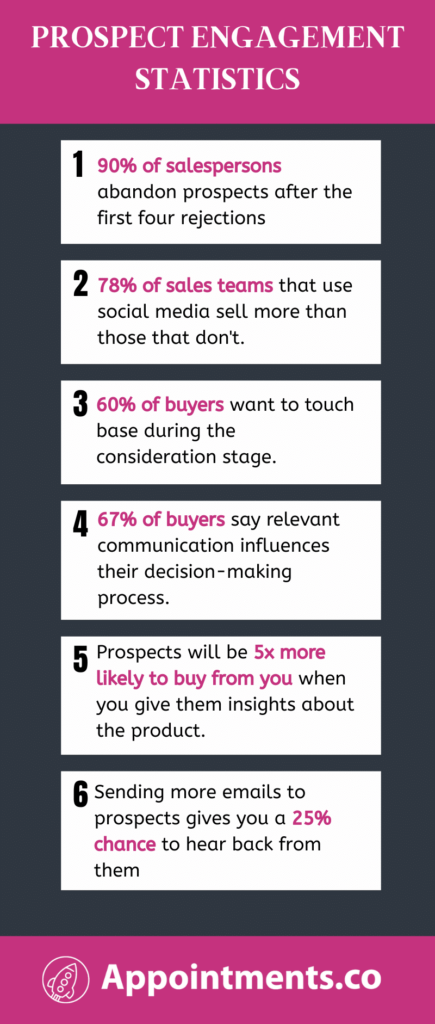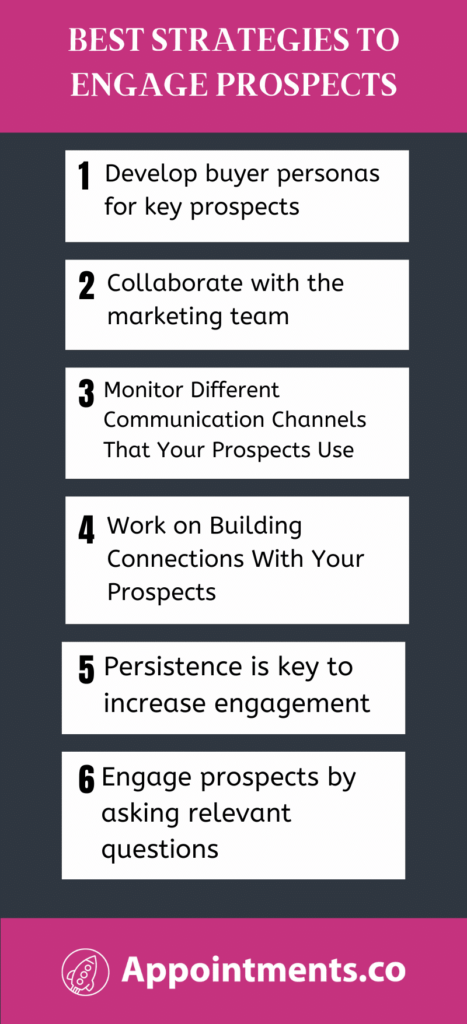Your audience doesn’t start out as customers who are willing to buy from you. With the right marketing techniques, you can turn leads into prospects. But even then, there’s still much to do to convert prospects into sales. That’s why the sales team needs to engage prospects to ensure that they still intend to buy from the company.
Prospect engagement is more than just communicating with sales prospects. Your goal is to capture and keep their attention on your business. With the right engagement strategy, you can set up appointments and close more deals.
This article discusses why you should engage prospects, and how to do it effectively.
- Why Should You Engage Prospects?
- How To Successfully Engage Prospects
- Frequently Asked Questions
- Wrap Up
- Related Reads
Why Should You Engage Prospects?
Now, that the marketing team has identified leads, it’s time for the sales team to step up. Even though these leads show interest in the company, you can’t guarantee that they’ll transact with you.
That’s what sales prospecting is all about. It helps the team identify and research the qualified leads more to learn how to sell to them. Another way of doing this is to engage with them. For some, it means sending out emails or connecting with them on social media.
But, the question is, do you really need to engage with prospects? Consider these statistics to understand why you should engage prospects to increase sales:

- Approximately 90% of salespeople abandon prospects after the first four “no’s,” but 80% of prospects decline an offer four times before accepting it.
There are a lot of reasons why a prospect would say no to an offer. But the statistics say that you need to engage prospects continuously (about 5 times) before they say yes.
- 78% of sales teams that use social media sell more than their peers that don’t.
A lot of people say that social media is a powerful tool for both marketing and sales teams, and it’s true. Most consumers these days have a social media account. Taking advantage of this fact can help the company increase its sales.
- 60% of buyers want to touch base during the consideration stage.
Buyers go through different stages in their buying journey, and the most crucial part for a salesperson is the consideration stage.
During this point, the buyer has already researched more about the company and the products you have to offer. That means they have a list of vendors they’re considering, and it’s up to the sales team to convince prospects to choose their company.
- 67% of buyers say relevant communication influences their decision-making process.
You should engage prospects earlier in their buying journey. But, for it to work, it has to go beyond transactional selling. What this means is that you shouldn’t be too insistent on making your sales. Your message and content should resonate with the prospects to better connect with their needs.
- Prospects will be 5x more likely to buy from you when you give them insights about the product.
It won’t make sense to buy something that you don’t need. But, there are times when buyers don’t know they need a product unless a salesperson sheds light on it. Showing the value of your products and services to your prospects can increase your chances of closing a deal.
- Sending more emails to prospects gives you a 25% chance to hear back from them.
It can be disheartening to not see any replies after sending an email to your prospects. But, don’t give up just yet. Keep sending those emails. You have a 21% chance of receiving a reply the second time you email your prospects and a 25% chance after that.
How to Successfully Engage Prospects?
The goal of prospecting is to move a consumer through the first two stages of the buyer’s journey. You should keep in mind that the end goal is for them to say, “Yes, I want to learn more.” As soon as you start talking about your products, you’ve already passed the first two stages.
But, how do you go about doing this while still staying ahead of your competitors? Here are some of the ways you can engage prospects to increase your sales.

#1 – Develop Buyer Personas for Key Prospects
Before you engage prospects, get their information, such as:
- Their issues and pain points
- Factors that influence them
- Their goals and interests
With these kinds of data, you can start developing buyer personas. By doing so, you’ll learn a lot about how potential customers engage with your business, websites, and brands. You can identify what brought them to your company and the best strategies for appealing to their demands.
#2 – Collaborate with Tthe Marketing Team
Marketing-generated content will be a major pillar of your engagement approach. These are the materials that the sales team will distribute through email or social media. It’s important to know the types of content they create to use the right prospect engagement strategy. For this reason, the sales team should team up with the marketing team.
You can set up a regular meeting where marketing discusses their editorial schedule and content plan. This will help you provide quick feedback, and be ready to make the most out of this material when it launches.
#3 – Monitor Different Channels of Communication That Your Prospects Use
One way of convincing your prospects to buy your products and services is to give them a good user experience. Pay attention to how they use your website and keep an eye on other avenues of contact, like Gmail and LinkedIn. Use a CRM system to track prospect interactions, and gain useful information about them.
Instead of sending out a generic message, use personalized messages. 76% of customers said that they consider brands that use personalization to contact them. It makes them feel that you took the time to understand their needs.
#4 – Work on Building Connections With Them
When your prospects feel more connected with the company, they’ll most likely trust you. To do this, you need to know their interests and what makes them tick.
You can also reach out to them in ways other than just the salesperson-customer relationship. Join them on Twitter or Facebook. Share a topic you believe they will find interesting. Find a worthwhile cause that they support, then center your relationship around it.
#5 – Persistence Is Key to Increase Engagement
You should be persistent when you pursue and engage prospects. It’s not usual to close a sales deal after only contacting prospects once. You’ll most likely need to do a follow-up, whether you’re contacting them face-to-face, over the phone, or by email.
Following up with your prospects is an important part of any sales cycle. It reminds your customers about certain problems that your company can help with. You can also notify them about new offerings that they may be interested in.
#6 – Engage Prospects By Asking Relevant Questions
As a sales representative, it is your job to convince prospects that your product or service is the answer. Ask them about their needs, business dealings, and issues to learn about their biggest pain points. Your questions will show them that you’re making an effort to pinpoint their issues and offer the right solutions for their needs.
Frequently Asked Questions (FAQs)
1. Do Leads and Prospects Mean The Same Thing?
Some people use “lead” and “prospect” interchangeably. If you’re in the marketing and sales industry, you should know that both of these terms don’t mean the same thing.
Leads are contacts that you connected withto, but haven’t communicated withback. They may have given you their contact information, but there’s no telling if they will engage with you further. Depending on your technique, not all leads turn into prospects.
Meanwhile, prospects are those that the sales team has identified to be a good fit. This means they either have engaged with you, or matched your ideal customer profile (ICP). Leads become prospects when they have communicated with a sales rep.
2. How MuchLong Time Should Tthe Sales Team Spend Time Prospecting?
The time spent for prospecting dependsrelies on how your sales department is set up. There are three types of sales organizations, and each has different times spent on prospecting:
– Complete Sales Organization: This type of sales organization means the sales team is responsible for the whole sales cycle. This means the team needs to divide their time in different ways. They canmostly spend as much as 30% to 40% of their entire week prospecting leads.
– Specialized Sales Organization: The company divides the sales process into different segments and creates sales development reps (SDRs). These SDRs arewill be responsible for sales prospecting. Because of this, they spend 90% of their time doing the process.
– Outsourced Sales Organization: Since the company decided to work with an external team, the sales team doesn’t have to prospect for leads.
Wrap Up
The sales process starts with prospecting, which is engaging with prospects to convince them to transact with you. There are a lot of statistics that show why the sales team needs to engage prospects.
And while engaging with prospects sounds easy, it’s not as straightforward as many people think. There’s more to it than just making calls or sending messages. Hopefully, this guide opens up a lot of ways for you to engage prospects successfully. With the right strategy, you can provide your prospects with a better sales experience and achieve your end goal.
Related Articles
Lead Nurturing – Important Factors You Need To Know
Best Practices of for Lead Sourcing
Illustrations: Storyset



